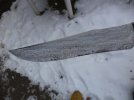What is your preferred method for final finishing of damascus steel?
I've noticed that many makers have (beautiful) high-contrast patterns that are nearly black on bright white metal. I'm guessing that the metal is darkened after etching, but have not been successful with my results. Whatever I try just looks muddy and dirty. It is possible that I am not etching it deeply enough, but I keep thinking I am missing a step.
The steel in this knife is W-1 and a 10% nickel/cobalt alloy. It was sanded to about 3000 grit prior to etching. Any suggestions would be greatly appreciated.

I've noticed that many makers have (beautiful) high-contrast patterns that are nearly black on bright white metal. I'm guessing that the metal is darkened after etching, but have not been successful with my results. Whatever I try just looks muddy and dirty. It is possible that I am not etching it deeply enough, but I keep thinking I am missing a step.
The steel in this knife is W-1 and a 10% nickel/cobalt alloy. It was sanded to about 3000 grit prior to etching. Any suggestions would be greatly appreciated.


